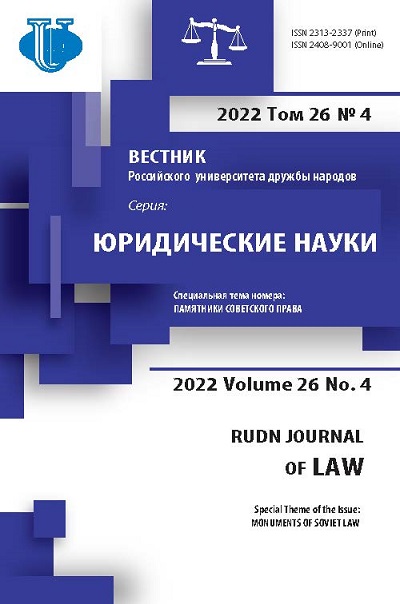Legislation on societies and unions of Soviet Russia (1917-1930s)
- Authors: Tumanova A.S.1, Safonov A.A.1
-
Affiliations:
- National Research University “Higher School of Economics”
- Issue: Vol 26, No 4 (2022): MONUMENTS OF SOVIET LAW
- Pages: 861-876
- Section: CIVIL AND LABOR LAW
- URL: https://journals.rudn.ru/law/article/view/32973
- DOI: https://doi.org/10.22363/2313-2337-2022-26-4-861-876
- ID: 32973
Cite item
Abstract
This article outlines a number of sources of law of various legal force that determine the legal status of non-governmental organizations in Soviet Russia in the 1917-1930s. Primarily, these are the Constitutions of the RSFSR and the USSR and Resolutions of the All-Russian Central Executive Committee and the Council of People’s Commissars on societies and unions. The authors examine doctrinal documents (resolutions of party congresses, excerpts from speeches by party leaders, etc.) that characterize self-organization of Soviet society and legal framework for the activities of mass voluntary associations. The legal foundations for voluntary associations operation in Soviet Russia, as well as specifics of legislative acts regulating their formation and activities, and the forms of control over them by the authorities, have not been fully studied in academic literature. This research aims to bridge this gap. Based on the analysis of a wide range of published sources, as well as the standpoint of modern methodology of critical legal research, the article investigates legal policy of the Soviet government aimed at developing a new legal framework for the activities of societies and unions including the principles of their relationship with the state in terms of formation, re-registration and termination of activities of mass voluntary organizations.
About the authors
Anastasiya S. Tumanova
National Research University “Higher School of Economics”
Author for correspondence.
Email: anastasiya13@mail.ru
ORCID iD: 0000-0003-3469-7144
Doctor of Legal Sciences, Doctor of History, Full Professor, Department of Theory of Law and Comparative Law, Faculty of Law, Center for Studies of Civil Society and Non-Profit Sector, Leading Researcher
3, Bolshoy Trekhsvyatitelsky lane, Moscow, 109028, Russian FederationAlexander A. Safonov
National Research University “Higher School of Economics”
Email: asafon1970@mail.ru
ORCID iD: 0000-0003-3577-5490
Doctor of Legal Sciences, Full Professor, Department of Theory of Law and Comparative Law, Faculty of Law
3, Bolshoy Trekhsvyatitelsky lane, Moscow, 109028, Russian FederationReferences
- Bukharin, N. (1926) The dictatorship of the proletariat and the organization of workers' correspondents. In: About rabkor and selkor: articles and speeches. 2nd ed. Moscow, Pravda; Bednota Publ. (in Russian).
- Bradley, J. (1994) Voluntary societies in Soviet Russia. 1917-1932. Moscow University Bulletin. Series 8: History, (4), 34-44. (in Russian).
- Bradley, J. (2009) Voluntary Associations in Tsarist Russia. Science, Patriotism and Civil Society. Cambridge, London, Harvard University Press.
- Bradley, J. (2016) Associations in Times of Political Turmoil: Science Societies and the Bolshevik Regime 1917-22. In: Lindenmeyr A., Read Ch., Waldron P. (eds.). Russia's Home Front in War and Revolution, 1914-22: Book 2. Vol. 3. The Experience of War and Revolution. Bloomington. pp. 152-178.
- Hutchinson, J. F. (1996) Champions of Charity: War and the Rise of the Red Cross. Boulder, Colo.
- Il’ina, I.N. (2000) Voluntary associations of Russia in the 1920s. Moscow, Institute of Russian History RAS Publ. (in Russian)
- Kiseleva, N.V. (1998) The emergence of the Soviet phenomenon of mass voluntary societies. Rostov-on-Don, Rostov State University. (in Russian).
- Koenker, D.P. (2014) Trade unions. In: Akton E., Rozenberg U.G., Cherniaev V.Iu. (eds.). Critical companion to the Russian revolution: 1914-1921. Saint Petersburg, Nestor-Istoriia Publ. рр. 396-405. (in Russian).
- Korzhikhina, T.P. (1981) The History of Voluntary Societies and Unions of the USSR in Soviet Historiography. History issues. (3), 114-123. (in Russian)
- Korzhikhina, T.P. (1986) Public organizations in the USSR during the transition period from Capitalism to Socialism. Diss. … Doctor of Historical Sciences. Moscow. (in Russian)
- Korzhikhina, T.P. (1992) The Soviet government and public organizations in 1917-1918. In: Voluntary associations in the political system of Russia. 1917-1918: Conference materials. Moscow. (in Russian)
- Korzhikhina, T.P. (1997) Please be trustworthy! Moscow, Russian State Humanitarian University. (in Russian)
- Medushevskii, A.N. (2017) Political history of the Russian Revolution: norms, institutions, forms of social mobilization in the XX century. Moscow, Saint Petersburg, Center for Humanitarian Initiatives Publ. (in Russian)
- Nemytina, M.V. (2014) Traditions in legal cultures, legal systems. In: Legal Traditions. Zhidkov Readings: Proceedings of the International Scientific Conference, Moscow, March 29-30, 2013. Moscow, Peoples' Friendship University of Russia. pp. 18-26. (in Russian).
- Pontovich, E.E. (1927) The Union of the SSR as a Union State. Pravo i zhizn’. (8-9), 8-10. (in Russian).
- Shchiglik, A.I. (ed.). (1983) Constitutional status of voluntary associations in the USSR. Moscow, Nauka Publ. (in Russian)
- Smit, D. (2018) Former people. The last days of the Russian aristocracy. Translated by Sokolova N. Moskva, Novoe literaturnoe obozrenie Publ. (in Russian)
- Tumanova, A.S. (2008) Voluntary associations and the Russian public at the beginning of the XX century. Moscow, Novyi khronograf Publ. (in Russian)
- Tumanova, A.S. (2017) Voluntary associations during the First Russian Revolution: legal foundations of functioning and relations with state power. State and Law. (11), 32-42. (in Russian)
- Tumanova, A.S. (2019) Voluntary associations in Russia: Legal Status. 1860-1930s. Moscow, Prospekt Publ. (in Russian).
- Yampol’skaya, Ts.A. (1972) Voluntary associations in the USSR. Some political and organizational-legal aspects. Moscow, Nauka Publ. (in Russian)
Supplementary files















